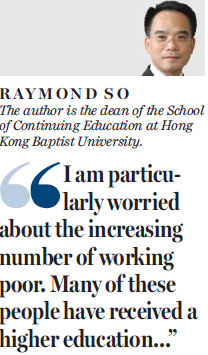The truly difficult job of fighting poverty in HK has still to be done
Updated: 2016-10-20 07:40
(HK Edition)
|
|||||||||
Last Saturday the Commission on Poverty held a summit that analyzed Hong Kong's poverty situation last year. In Hong Kong, the poverty line is defined as half of the median household income. This definition was published by the commission in 2013, using the concept of "relative poverty". Under this definition of poverty, no matter how hard the government is working on fighting poverty, there is always a class of people who will live in poverty because, by definition, there will always be people earning half the median household income. According to the official definition of the poverty line, a single-person family earning a monthly income of HK$3,800 falls into the section of society who are poor, while the thresholds for two-person and three-person families are HK$8,800 and HK$14,000, respectively. Based on this definition, the Commission on Poverty declared that there are a total of 1.35 million poor people in Hong Kong, which represents an increase of 20,000 people compared with 2014. The overall poverty rate in Hong Kong last year was 19.7 percent, which means that nearly one out of every five people is poor. This is a very sad finding.
From an academic point of view, poverty is an inevitable thing. Human societies are characterized by an unequal share of resources. Many academic studies have documented the "80-20" phenomenon, which suggests that 80 percent of the wealth is owned by 20 percent of the people. In fact, no matter how affluent our society is, poverty is simply inevitable. This phenomenon also occurs in other big cities. The disparity between the rich and the poor is getting worse.

There is no silver bullet which can solve the problem of poverty. In general, governments around the world use social welfare payments as a means to reduce the number of poor people. In Hong Kong, the government uses various welfare measures such as Comprehensive Social Security Assistance, public housing and Low-income Working Family Allowance to help alleviate poverty. According to government data, after the implementation of a variety of welfare transfers the number of people in poverty dropped to 670,000 last year - which is exactly half of the commission's number of people in poverty. This also indicates that welfare payments are effective in reducing the number of people in poverty.
However, there are two points about welfare payments we need to pay attention to. First of all, many people make the criticism that the government uses welfare payments to manipulate the data so the number of poor people can be reduced. This criticism is simply not correct. Internationally, it is a common practice to include welfare payments when discussing the overall poverty situation. The concept is simple. If welfare payments are not included, the real income levels of households will be underestimated and this will result in misleading results. In Hong Kong, for example, there are more than 700,000 households living in public rental housing. The rents for public housing are much cheaper than market rates, and if we do not include housing benefits we may reach the incorrect conclusion that those living in public housing are worse off than those living in subdivided flats. We can criticize the definition of the poverty line for being too loose, and many households do not make a decent living even though they are not officially in poverty. However, it is both incorrect and unfair to accuse the government of playing around with the data.
Second, welfare payments are a direct and effective way to reduce poverty in the short term. But they are only a temporary solution, because if poor households can only get out of poverty through welfare payments, it is safe to say that the poor will never really get out of poverty. Social welfare should not be regarded as a tool for totally eliminating poverty, but rather a short-term means to lessen the seriousness of the problem. Other long-term solutions include creating opportunities for upward social mobility, and improving fiscal redistribution. Yet these long-term solutions will take years to yield results. In the short term, welfare payments are still inevitable.
I am particularly worried about the increasing number of working poor. Many of these people have received a higher education and the number of degree holders who fall below the poverty line has increased. Sadly, a higher education does not necessarily imply greater competitiveness in the job market; however, these well-educated young people represent society's investment in the future. When these young people cannot find a decent job to help them get out of poverty, clearly there is a mismatch of skills in our society. This is worrying, as these well-educated young people can become alienated, leading to social instability.
The results of efforts to alleviate poverty are still far from satisfactory. Given the challenges ahead, poverty reduction will certainly be more difficult in future.
(HK Edition 10/20/2016 page8)